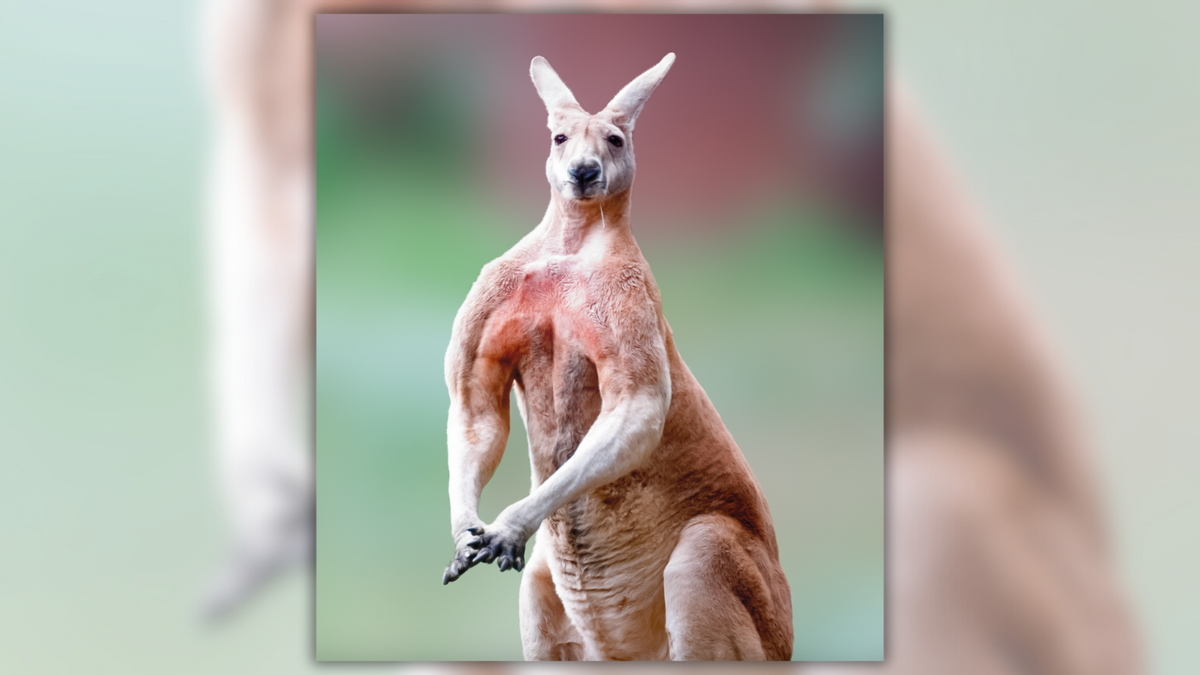Although male kangaroos do appear to flex their muscles to show off their impressive figures, researchers in a 2013 study said it is not currently possible to determine whether or not such behavior is a conscious move to show off to female kangaroos. One of the authors explained that, as of this writing, humans do not fully understand animal consciousness, therefore it would not be possible to definitively state whether this claim is true or false.
A claim that male kangaroos flex their muscles to impress potential mates has circulated on social media platforms for at least a decade.
One such version of the rumor appeared on TikTok on April 5, 2024 (archived).
"It's not just men who flex their biceps to impress the opposite sex — kangaroos do it too," a caption accompanying the post read. "According to studies, male kangaroos frequently adopt poses to show off their muscular arms in order to attract females."
In short, w
Therefore, unless science advances to a level where humans can study consciousness in animals, the claim that male kangaroos purposely flaunt their guns to show off to a female partner will remain unproven.
How Did the Claim Originate?
The claim that male kangaroos flex their muscles to impress females appeared to refer to a 2013 study published in the Biological Journal of the Linnean Society, which was titled: "Sexual selection on forelimb muscles of western grey kangaroos (Skippy was clearly a female)."
After the study's publication, numerous media outlets published articles with headlines such as: "Male kangaroos woo mates with bulging biceps," and: "How kangaroos woo mates: The males flex their biceps."
The subheading of an article in Smithsonian Magazine — of the U.S. research institute Smithsonian Institution — even read: "Male kangaroos strike poses that show off their arms." The first paragraph added:
Any gym-going female human knows just how much men like to show off their muscles. But it turns out that it's not just male humans who think that flexing their biceps at ladies is an effective strategy to win them over—kangaroos do it, too. According to new research published in the Biological Journal of the Linnean Society, male kangaroos strike poses that show off their arms.
Such reporting likely contributed to social media users inferring that male kangaroos consciously flex their biceps to impress females.
However, this wasn't the pull picture...
What Did the 2013 Study Find?
Its abstract, published on July 12, 2013, contained the following passage:
The significant positive allometry in male forelimb musculature, particularly those muscles most likely involved in male–male combat (a group of muscles involved in grasping: shoulder adduction, elbow flexion; and pulling: arm retraction, elbow flexion), clearly suggests that this musculature is subject to sexual selection. In addition to contributing to locomotion, the forelimbs of male kangaroos can also act as a signal, a weapon, and help in clasping, features that would contribute towards their importance as a sexually selected trait. Males would therefore benefit from well-developed musculature of the arms and upper body during competition for mates.
In short, this means males who grow bigger biceps are more likely to succeed in sexual selection — a mechanism of evolution that allows some members of a species to have "an advantage over others in terms of mating," as defined by the University of Cambridge. "It is the selection for traits that are solely concerned with increasing the mating success of an individual."
Therefore, female kangaroos may perceive males with larger biceps as stronger and as more suitable mates.
Likewise, the rest of the study drew no such conclusion. Instead, it found that the muscles in the forelimbs (including biceps) of kangaroos are a sexually selected trait. Therefore, females may select males based on them having bigger biceps, but nothing suggested males knowingly flex those muscles.
What Did the Study's Authors Say?
Murdoch University's Natalie Warburton, an associate professor and zoologist who has extensively researched marsupial anatomy and who co-authored the 2013 study, confirmed in an email her team's research "didn't test male behaviour or female preference."
In fact, she said the authors "don't state anywhere" in the study that males "flex their biceps" to impress females. Instead, the visual impact of having larger forelimb muscles may allow males "to signal their competitiveness" to other males "in gaining access to females." She also explained how larger biceps would give a male a physical advantage should combat with another male take place.
"We don't know, however, to what extent females use these visual signal to choose which males they mate with," Warburton continued.
The zoologist did quote separate 1983 and 1991 studies by Peter Jarman, a professor who has studied the behavior and ecology of mammalian herbivores and macropodidae, a family of marsupials that includes kangaroos. Warburton said Jarman found that "dominant males will frequently adopt poses which best display their muscularity and size."

(Peter J. Jarman in "Advances in the Study of Behavior," Volume 20.)
However, the passage, shown in the above screenshot — from page 11 of Jarman's 1991 journal article titled "Social Behavior and Organization in the Macropodoidea" in "Advances in the Study of Behavior, Volume 20" — did not explicitly state such flexing behavior was done to impress females.
Warburton's fellow co-author Bill Bateman, an associate professor in the school of molecular and life sciences at Curtin University, echoed her statements in an email. He added that males "reach up to their tallest height, and flex muscles when they see a rival or a predator" to get "ready for a show down."
"If the rival or the predator then backs off without a fight, that signal has worked without having to risk a fight - it is an 'honest' signal of how buff and capable and ready to fight that male is. It's a simple evolutionary step for an animal like a roo to start using that muscle flexing as a signal rather than just getting ready to fight."
He also said it was not possible to conclude whether male kangaroos knowingly flex their muscles to impress females (emphasis in bold ours):
If you are asking if they are subconsciously or consciously flexing muscles you are asking questions about animal consciousness and we simply don't have answer to that - what consciousness is in humans is one of the great unanswered questions, let alone other animals. However, if we ask, is flexing muscles in roos ADAPTIVE in the evolutionary sense of will it help that individual get its genes into the next generation, then yes, it is adaptive - muscles are an honest signal of a high quality male in roos and displaying them will potentially both attract females and warn off other males.
Bateman then explained how the flexing of muscles in male kangaroos "is at least analogous to human behaviour displaying health and attractiveness via muscles," but added that "how other males and females react to this, we just don't know, but in terms of evolutionary fitness it seems to work by allowing those big males to have access to more females and to mate with them."
When asked whether there were any similar studies proving male kangaroos purposely flex their biceps to impress females, Bateman said he is "not familiar with any," while Warburton explained how Jarman's work "makes statements about the likely visual cues of enlarged overall forelimb muscle mass."
Elsewhere, Diana Fisher, an associate professor and marsupial expert at the University of Queensland in Australia, said that while male kangaroos flexing their muscles is "not completely implausible," the behavior is "not a demonstrated factor in female mate choice and male paternity success of kangaroos."
"There have been quite a few studies of sexual selection in kangaroos, they have shown that body size and position in the hierarchy influence female choice, as well as being genetically healthy (and being available- having a large spatial overlap with the female) are important," Fisher wrote.
"Long arms and large arm muscles influence male fighting ability, so position in the hierarchy. All studies that have looked at paternity have found that large males with strong arms are limited in their dominance of actual mating success because females also mate with smaller males."
In other words, forelimb development may just be a part of everyday kangaroo life.

